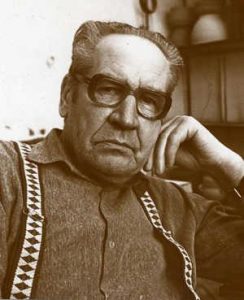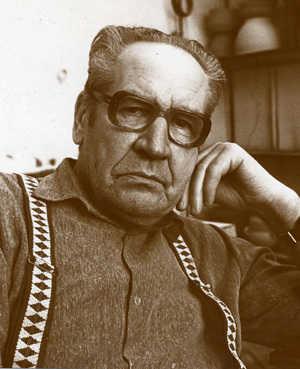Ceramist (1918-2001). He was born on September 23, 1918 in Preili district in Dubes. He begins to learn craftsmanship at an early age with his father and uncle P. Vilcans, whom he considers as his teacher. From 1935 he is engaged in ceramics on his own.
In 1938 his works were taken to art salons in Riga. In 1957 S. Vilcans moves to Daugavpils, where, working in an improvement enterprise as a potter, during free time he turns to works “for his soul”. In 1960 he was taken into the TDM. From 1971 to 1991 he worked in the Creativity Association “Creative Work” (“Daiļrade”). In 1983 S. Vilcans was taken into the Latvian Artists’ Union. Because of masters, in Daugavpils started to develop pottery, the National Decorative Arts Studio “Latgale” was created, ceramic traditions of Silajāni were saved and developed. In 1985 he was awarded the title of All-Union Creative Art Winner. He made beautiful vases, cups, candlesticks, in which natural colors of the native land are reflected.
In 1942 during the Second World War S. Vilcans participated in an exhibition in Preili and was awarded the diploma. Since 1947 he actively participated in exhibitions. The important exhibitions: in 1978, 1980 in France; in 1980 in Riga; in 1979, 1980, 1982 Latgalian ceramics in Moscow; in 1979 in Hungary; in 1979, 1991, 1995 in Lithuania; in 1983 in Bulgaria; in 1986 in Portugal, Poland, Germany; in 1991, 1992 in the Republican exhibition of Folk Applied Art in Riga; “Paintings and Ceramics” (“Gleznas un keramika”) in Zarasai (Lithuania); Latgalian ceramics in Jekabpils region; works of TLMS “Latgale” in the Daugavpils Theatre; in 1993 ceramics of Latgalian artists “My land – my father’s land” (“Mana zeme – mana tēvu zeme”); in 1995 Latgalian candlesticks in Vilnius (Lithuania); in 1996 “Days of Art` 86” (”Mākslas dienas`86”) in Daugavpils; “Harvest Festival” (“Pļaujas svētku”) exhibition in Rezekne; in 1998 “Dedication to the Latvian Song and Dance Festival” (“Veltījums Vispārējiem latviešu dziesmu un deju svētkiem”) in Riga; the ceramic exhibition of the Baltic States in Riga.
His works are in many Latvian museums, as well as in private collections, also abroad.
He died on December 9, 2001 in Daugavpils.



